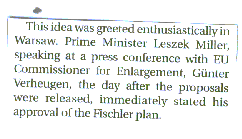

Would you like to receive publication updates from HLT? You can by joining the free mailing list today. |
Humanising Language Teaching
Year 6; Issue 1; January 2004
A GRAMMAR of STYLE, or: CO-TEXT in CONTEXT
Grzegorz Spiewak, Poland
By way of warming up, consider the following text, sent to me recently by an e-pen friend:
The paomnnehil pweor of the hmuan mnid.
Aoccdrnig to a rscheearch at Cmabrigde Uinervtisy, it deosn't mttaer in waht oredr the ltteers in a wrod are, the olny iprmoetnt tihng is that the frist and lsat ltteer be at the rghit pclae.
The rset can be a total mses and you can sitll raed it wouthit porbelm. Tihs is bcuseae
the huamn mnid deos not raed ervey lteter by istlef, but the wrod as a wlohe.
Amzanig huh?
Amazing it is, and not just because of its spelling. More importantly, this passage can be seen as an anecdotal manifestation of the fact that texts have a life of their own, which is not a mere cumulative total of the words (and phases) that they are made of. For want of a better term, let me resort to the overexploited phrase grammar of text as a shorthand for a whole collection of phenomena and corresponding awareness-raising exercise types that I shall present. It is through enhanced awareness of text as a unit of grammatical organization that learners can develop an ability to read quite a lot of grammar off the texts they are studying, and subsequently back into the texts they will be producing themselves.
Let me note at the outset that the very term grammar of text is a token of my commitment to the existence of several types of grammar not such a massive act of courage in view of years of genre analysis on the one hand, and of the monumental 'Longman Grammar of Spoken and Written English' (LGSWE), on the other. The reason I wish to promote a grammar of text is not a desire to push research further, but to bring its results somewhat closer to the language classroom, where in my experience the bulk of grammar teaching still consists in phrase- and sentence-level generalizations. Disappointingly little use is made, in everyday classroom practice, of Ronald Carter's insight:
- 'More recently, the language awareness approach has evolved alongside advances in language description which go beyond the single sentence. [
] In general, language awareness is characterised by a more holistic and text-based approach to language'
Ronald Carter's talk Language Awareness Revisited: a Fifth Skill
IATEFL York 2002
The main reasons for this, to my mind, are:
- a fear that the moment one goes beyond the single sentence, one inevitably finds oneself on the shaky ground of stylistics: imprecise, weak, situation ('context') dependent recommendations rather than solid grammar rules;
- a conviction that, in any event, text control is an advanced linguistic skill, something to be taught to English majors rather than to the average learner.
In my view, both of these are fundamentally misguided. First, there is nothing sacred about the space between the sentence-initial capital letter and the sentence-final full stop that would justify obsessing with the phenomena inside rather than outside that space. Secondly, Biber at al. have provided over 2000 pages of evidence against a simplistic, gender-less sentence-level grammar; once you leaf through the pages of LGSWE, you cannot but start thinking of grammar in the plural, with a great number of familiar rules coming out rather shaky. Thirdly, it is a major strategic mistake to postpone text teaching till later: whether we like it or not, we have to deal at all levels of language (in)competence - with pieces of learner writing that feel distinctly un-English, even though they do not contain typical phrase- and sentence-level errors. And if we fail to take on these textual problems, we end up drawing vertical lines on the margin and scribbling 'style' together with a varying number of frustrated exclamation marks. Here is a typical (pre-intermediate) sample:
- My grandmother's house was a small one with two bedrooms and a sitting room. A large garden was behind the house. My grandfather had planted a lot of flowers in the garden. Hyacinths and roses were these flowers.
One of our teaching nightmares: good vocabulary, no major grammar mistakes. So, what's wrong with this piece of writing? Crucially for the purpose of my argument, each of the sentences above, taken alone, is reasonable. Yet they do not 'gell' as a piece of English text. Bad style? What is 'style', though?! This is precisely where I used to get most frustrated as a learner of English, seeing my written attempts all covered in red ink, with bits and pieces underlined in what I thought was random manner and the wretched 'style' invariably jeering at me every other line. Now, 20 or so years wiser, I have come to realize that what my teacher meant was more often than not text-level grammar.
Returning to 'grandma's house', its clumsiness as a text is mainly due to the inappropriate arrangement of old and new information, i.e. to a certain aspect of its word order, which can be noticed only when we go beyond the single sentence. Now, how about the following version:
- My grandma's house was small, with two bedrooms and a sitting room. Behind the house (there) was a large garden, where my grandfather had planted a lot of (flowers:) hyacinths and roses.
Note that we are not dealing here with an admittedly vague notion of 'context' but rather with a crucial influence of co-text (i.e. surrounding language) on a given choice of words. An awareness of co-text is fundamental to producing one, which entails that any responsible teacher needs to teach careful ('committed') reading as a prerequisite for text production. And any responsible learner cannot afford only to read English for pleasure, just like a musician, who never listens to the melody only, but also to that cello in the second movement being a quarter-tone off key. Frustrating, yes, but necessary for the discriminating powers to remain in good shape. This is how I read Michael Hoey's appeal:
- 'The learner needs to be shifted in focus from a shallow reading to a committed reading'
Michael Hoey, plenary talk
IATEFL Poland Wroclaw 2003
In my personal learning history, reading in the committed way has had an unexpected side effect in that I read more and more slowly, pausing over Rowling's overuse of Present Perfect or Frank McCourt's numerous violations of relative clause punctuation rules. As for workable ways of fostering such a gradual shift from 'shallow' to 'committed' reading, how about a little project idea:
- Task: over the next two weeks, collect different patterns used to refer to a person's name and professional position/ function/ role. Once you discover a pattern, try to find at least 2 or 3 examples of it. Transfer each pattern onto a separate piece of paper to be displayed as a collection of posters in class.
The motivation behind this sort of activity is to force the learner to notice a certain feature of a specific type of text, i.e. read the relevant bit of grammar off this text type by reading in a careful, committed way. Some examples of such poster material are provided below:




Noticing is not an end in itself, of course, but a way for learners to start generating patterns like those above in their own texts, from the uncontroversial President Bush/ Prime Minister Blair/ etc., which even advanced students tend to 'refuse' to notice.
To recap, I have tried to show that one way to help our learners is to get them to notice co-text as a special layer of grammatical organisation, before they attempt to produce any text themselves. The range of phenomena in question is much wider than the overemphasized linking expressions or articles, and includes among others tense control, patterns of reference (grammatical vs. lexical), and passive vs. active choice, to mention but a few. Linkers are worth noticing for quite the opposite reason in fact: recent research suggests that non-native writing contains several times more linking expressions than the native variety possibly a result of our insistence on learners' using a lot of 'howevers' and 'althoughs', particularly at pre-FCE levels.
Most of the above can be exemplified with the following extract, yet another authentic piece of learner English:
- ......Peter went out of his bed and stepped on a snake. When he was trying to get rid of him the snake bit him and hid somewhere. After having phoned the police and a doctor he started to look for the snake. But once the snake disappeared it was impossible for Peter to find him. While he was waiting for help, he felt strange dizziness....
The features of co-text to be noticed here are linkers, tense sequencing, as well as reference to 'Peter' and to 'snake'. The last problem is particularly interesting as an instance of grammar-lexis interface: apart from the grammatical substitution with 'he' and 'it', one would welcome recourse to lexical sets ('boy', 'victim', 'poor guy'; 'animal', 'creature', 'beast', 'reptile' and so on).
In this perspective, deviant pieces of writing like 'Peter & the snake' and 'Grandma's house' above are just as much of a gift to the teacher as 'mainstream' grammatical errors are. They can be exploited as material for pair/ groupwork analysis and subsequent editing, with salient points amplified by the teacher.
Grammar of text made precise
Once we get our learners (and ourselves) to recognize grammar of text as a unique layer of grammatical organization, we are in for an unexpected bonus: the discovery that its recommendations can actually be made very precise. To see this, look at the following extract, again taken from a low level material, this time an English course book for pre-intermediate learners.
- STEP 1: Choose the verbs forms that are most natural in the text as it stands:
Next, we visited the market. It was amazing. There [1] _____________________ (hundreds of colourful stalls; sell; all sorts of fantastic things). after that, [2] we listened/ were listening to the music until three a.m.
[ ] At eight o'clock on Sunday night, the surprise band arrived. [ ] It was Oasis, my all-time favourite. They [3] played/ were playing for over two hours and the crowd [4] ______ (adore) them. [ ] Everyone was relaxed and friendly. People [5] talked/ were talking to each other and [6] _____ (share) their food and drink.
[adapted from ForMat 1, p.144, publ. by Macmillan Polska]
I have done this task with a number of teacher groups, including my IATEFL Poland Wroclaw audience last September. Invariably, a lot of people opt for Past Continuous forms in items [2], [3], and [5], while the original ones were Past Simple throughout. Surprising? Well, yes and no. On the one hand, they are all English teachers and as such should not have any problems with a pre-intermediate text. But then, the choice of text is not accidental it manipulates the Polish learner, who is struggling against two enemies here. The first one is mother tongue interference: in this type of text in Polish we use imperfective rather than perfective verb forms. The second 'offender' are the time expressions: 'until 3 a.m.' and 'for over two hours', which we learn as characteristic exponents of a continuous tense.
The crucial thing is that we can only see the problem if we notice what sort of past narrative the above text is. Note that as it stands the text consists of a sequence of events of more or less equal importance, with no central, dramatic event that would make the others constitute its background. In such type of narrative, the verb forms are typically Past Simple, no matter what our sentence-level 'rules' might suggest to the contrary. A grammar of style, what else?!
And the best part of the activity is arguably the point when we invite our learners to re-design the text, to accommodate alternative verb forms:
STEP 2: what changes to the original text could you suggest to license the use of alternative tense constructions?
Note that this sort of activity shakes off the straightjacket of single-sentence gap-fills, in which it is always the verb that has to adjust to the rest of the sentence. Those wretched drills, used most obsessively by Thompson & Martinet, brainwash the student into believing that verbs are the only part of the system that keeps changing, while the rest remains static. As my task demonstrates, this is not only unhelpful, but plainly harmful and more often than not leads to forging false usage generalizations.
The same motivation, i.e. refocusing the learner from the verb form(s) alone to the surrounding co-text, underlies the following exercise type, tried and tested in both variants with my students.
Version A:
Consider the sentence below. Match the forms of the verbs in [A] [D] and the situations in [a] [d]:
If you _________ (send) her some flowers, she __________ (forgive) you.
| [a] It always works when she's angry. | [A] send / will forgive |
| [b] It's always worth a try | [B] sent / might forgive |
| [c] Pity you didn't do sth. right away. She always takes time to think things over. |
[C] had sent / would forgive |
| [d] To lose a woman like that, really! | [D] had sent / would have forgiven |
(The key: [a] + [A]; [b] +[B], etc. One of the columns would have to be shuffled for in-class use, of course). A multiple matching like this, albeit an improvement over a classic single-sentence gap-fill, is still essentially about the forms of 'send' and 'forgive'. A step forward? 9
Version B:
- Give only the target sentence and the verb forms [A] [D]
- get students to co-textualise the verb forms, by writing one or two sentences of co-text that could conceivably precede or follow the target sentence.
My own experience tells me that version B is an opportunity for students not only to juggle the four sets of verb forms, but also to try their hand at colloquialisms, idioms, and so on. Most importantly, verbal grammar is made an integral part of text building.
how texts 'gell' or: grammar of text in action
In my experience, co-text writing is one of the most effective grammar exercises at all levels. Below is yet another variation on that theme, this time clearly targeted at advanced learners.
Variant A:
Write a few sentences to create a context in which each of the following sentences would appear natural. The target sentence can come at the beginning, at the end, or in the middle. It can also be part of a longer sentence in this case, you may change the original capital letter to a small case one. No other changes are allowed, though!
- The Prime Minister congratulated the troops.
- The troops were congratulated by the Prime Minister.
- It was the Prime Minister who congratulated the troops.
- What happened to the troops was that the Prime Minister congratulated them.
Variant B:
(a less radical or preparatory alternative to Variant A). Match the four sentences above to the four co-texts provided:
- After heavy fights on the western front, more and more soldiers are coming home. Yesterday, the second regiment of light tanks, whose heroic attacks had proved to be decisive, disembarked. _____________________________________
The morale of our soldiers is not particularly high today. They have held the positions for two months. Heavy rains, lack of supplies and frequent attacks of the enemy have exhausted the soldiers. They badly need replacement by fresh troops. This was promised repeatedly but without any result. The visit of the PM was to have been the event bringing them well-earned rest. _______________________________________. Soon afterwards he left and the situation remained unchanged.
Tony Blair arrived at the front line early in the morning. He paid a visit to the headquarters to hear the news about the enemy's defeat and insisted on visiting entrenchments where soldiers still held positions. Then ___________________________________ .
Rectification.
We apologize for the incorrect information printed in yesterday's issue of our newspaper (12 March 1996) in the article entitled "Heroes coming home". ______________________________, not the Minister of National Defence as was formerly stated.
(Key: 1 B ; 2 D ; 3 A ; 4 C)
As with past tenses and conditionals above, the main point is to show the learner that the choice between, say, active and passive is not primarily a syntactic, sentence-level permutation, involving juggling the right form of the auxiliary and of the past participle, but essentially a resource for the language user to draw from, depending on what sort of text s/he is producing.
To conclude, the above is but a small sample of a whole range of activity types whose underlying aim to put co-text in context. Henry Widdowson certainly has a point when he questions the pedagogical validity of 'authentic' examples, arguing that the great majority of such examples are deficient and ultimately inappropriate for the learner due to the fact that their authentic context is always missing (cf. his plenary talk at IATEFL Brighton 2003). To address this problem, I wish to suggest that what we can and should hope for in everyday teaching is not contextualising grammar, but co-textualising it. It is arguably the latter that's teachable, learnable, and genuinely useful.